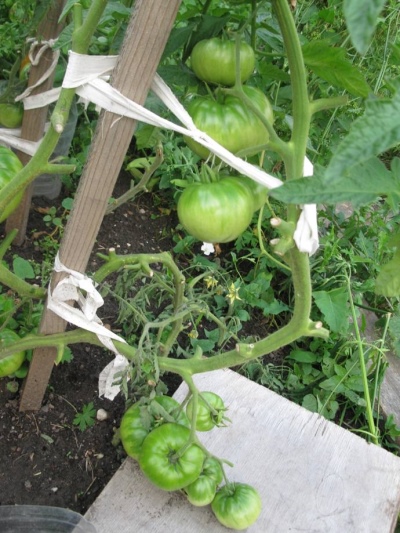
- Authors: Kononov A.N., Krasnikov L.G., Stolpnikova T.V.
- Year of approval: 2005
- Category: grade
- Growth type: indeterminate
- Appointment: fresh consumption, for juice, for ketchup and tomato paste
- Ripening period: mid-season
- Growing conditions: for open ground
- Transportability: Yes
- Marketable fruit yield,%: 86%
- Bush size: tall
Shuntuk giant - the name of the variety, hinting at the large size of the berries, is liked by many summer residents and gardeners. However, only those of them who get to know him better will be able to prepare properly for the landing. And it is they, as it is easy to understand, who will be able to get a solid harvest.
Breeding history
The plant was created by three leading breeders - Kononov, Krasnikova and Stolpnikova. The official registration of the culture took place in 2005. Since then, it can be grown in private gardens.
Description of the variety
The Shuntuk giant develops according to an indeterminate pattern. This culture manifests itself optimally in open land. Its bushes reach a height of 2 m. Strong growth is typical for them. Medium-sized leaves are distinguished by a simple green color.
The main qualities of the fruit
The berries of the Shuntuk giant are initially light green in color. In the region of the peduncle, a characteristic spot of dark green color is formed. When ripe, the harvest turns red. The average weight of the fruits is 450 g. They are flat in shape, the ribbing is not too pronounced.
Other features:
3 or 4 berries appear in 1 brush;
inflorescences belong to the intermediate format;
the first inflorescence will be laid over the 9th leaf;
the next inflorescences will be laid with a step of 1-2 leaves;
the peduncle of this variety is invariably articulated.
Taste characteristics
Often the fruits of the Shuntuk giant are eaten fresh. But they are also readily used for juices, ketchups and tomato paste. The pulp is sweet and fleshy. The lower the brush on which the fruit has developed, the less the concentration of seeds will be in it.
Ripening and fruiting
The Shuntuk giant is classified as a mid-season tomato. The share of marketable berries reaches 86%. It is worth noting that with errors in cultivation, the crop may lose its taste. But with proper storage, it will not deteriorate for a very long time.
Yield
The declared ability to produce 12.9 kg of fruit per 1 sq. m. Of course, this result is possible only under favorable weather conditions. And you will also have to make some practical efforts for it. With normal care, it is quite possible to collect 3 kg of berries from a bush.
The timing of planting seedlings and planting in the ground
It should take about 2 months between planting seeds in containers and planting seedlings in open ground. The specific term is selected taking into account the characteristics of the region. But in addition, you need to look at the long-term weather forecast. Experts advise treating the seeds with a growth stimulant before sowing.

Growing tomato seedlings is an extremely important process, because it largely depends on whether the gardener will be able to harvest at all. All aspects must be taken into account, from seedbed preparation to planting in the ground.
Landing scheme
For 1 sq. m there can be no more than 2 bushes. With a thickened planting, problems are inevitable. It is hardly possible to find more precise indications.

Growing and care
Predictably, the Shuntuk giant will have to be tied up. Shaping the bushes will also be absolutely necessary. The variety is optimal for growing in a greenhouse. But in the southern regions of Russia, it can also be planted outdoors. True, you will have to carefully prepare the seedlings.
Seeds are disinfected with diluted potassium permanganate before sowing. Planting goes to a maximum depth of 1.5 cm. Seedlings can only be watered with a spray bottle. Immediately after that, the boxes are wrapped in foil or covered with glass. The protection is removed after the sprouts emerge.
Transfer to open ground is carried out only after the end of the danger of frost. The wells are recommended to be saturated with small amounts of organic fertilizers. It is advisable to water the plants in the evening. If the foliage casts a shadow on the fruit, it can be cut off. Protection against infections and pests will be more effective if plants are sprayed with special preparations; soapy water or infusion of celandine can serve as a home substitute.




A plant needs different micronutrients at each stage of growth. All fertilizers can be divided into two groups: mineral and organic. Folk remedies are often used: iodine, yeast, bird droppings, eggshells.
It is important to observe the rate and period of feeding. This also applies to folk remedies and organic fertilizers.


Resistant to adverse weather conditions
This tomato is considered to be dry-tolerant. At the same time, excessive moisture is categorically contraindicated. And also the Shuntuk giant does not develop well on saline soil.
Growing regions
This plant is suitable for:
Western Siberia;
central Russia;
Ural;
The North Caucasus;
Of the Far East.

























































































